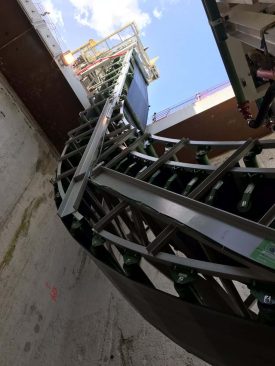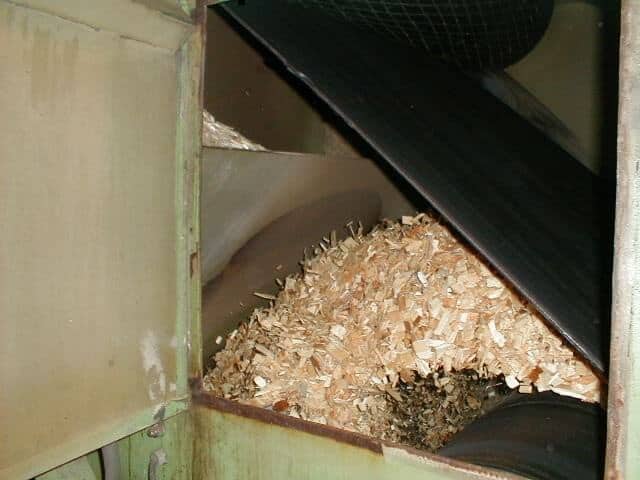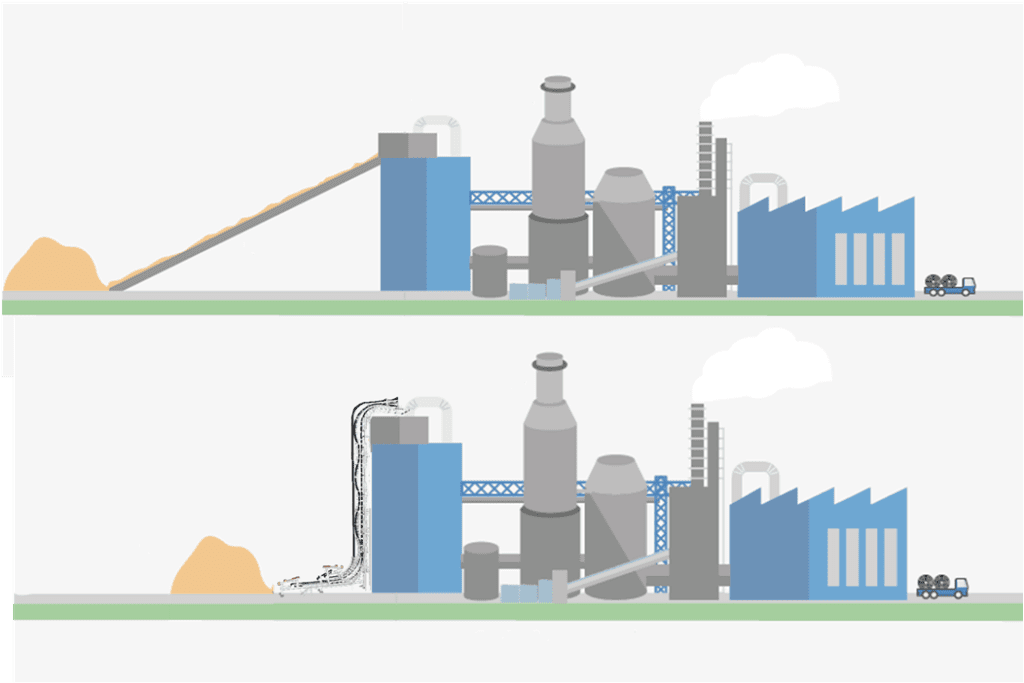Sandwich belt high angle conveyors have been commercialized for over 30 years. During that time, units have been used to elevate various large materials. They’ve proven both versatile and reliable in applications like shiploading, in-pit conveying, tunneling and even for pulp, paper and biomass. When investigated anew in the late 1970s, it was clear that the sandwich belt concept offered the greatest potential for a cost effective, operationally appropriate high angle conveying system to address the broad needs of the mining and bulk materials handling industries.
Sandwich belt conveyors fulfill all established operational requirements. The profiles can conform to a wide variety of applications. At its inception, a large scale prototype was created to test several materials from various grades of coal (run-of-mine, sized and washed) to coal refuse, to coarse copper ore, excavated earth, dewatered sludge, wood chips, to blast furnace slag, gypsum and various grains to prove the suitability of the system. Conveying rates varied from a low of 0.272 t/h to a high of 4,000 t/h. Conveying angles vary from 35 degrees to 90 degrees. Elevating heights are as low as 3.66m and as high as 216m. These same high angle conveyors are respectively the shortest, at 8.6m and the longest at 582.8m.
NO DAMAGE TO WOOD CHIPS

With interest in wood chip and grain handling, damage testing was performed on three USDA Grade 1 grains to demonstrate the gentle distribution of hugging pressure on the material in the Sandwich conveyor. This test was especially significant for wood chip handling applications where chip degradation is of great concern. Five one-bushel samples were loaded into oversized burlap sacks from each of a common batch of soybeans, wheat and seed corn.
The first bushel of each grain was set aside to serve as the control sample, while the next four bushels were conveyed at 60 degrees, the full length of the prototype. They were tested two, four, six and eight times respectively for corresponding conveying distances of 45.7m, 91.4m, 137.2m
and 182.9 m. Samples (2,555g) from each bushel sack were then analyzed at a State of Alabama Department of Agriculture laboratory for the various forms of damage and contamination, and at the Alabama State Seed Laboratory Department of Agriculture and Industries for germination potential. The results showed no damage to any of the three grains tested, as a result of conveying in the high angle conveyor prototype.
The tests proved that conveying up to 60 degrees proved very successful and indicated no limit on conveying angles of up to 90 degrees (vertical). Sandwich belt high angle conveyors are thus offered with conveying angles of up to 90 degrees, as in the latest two Sandwich conveyors handling tunnel muck at the Paris Metro project.

HAULAGE FROM TRAIN OR TRUCK LOADOUT
In this installation, wood chips were received from trucks or trains and delivered to an open stockpile or to the first stage screening house. The accepts were fed by conveyor onto the sandwich belt for elevating to the metering bins of the second stage screening the chips go on to the thermo-mechanical pulp mill. This 914mm “S” shape vertical Sandwich belt system lifts 66 t/h of chips 15.5m vertically to feed the pulp mill.
SCREENING
Another unit was an important part of a chip thickness system located in Canada. This 1219mm (L-shape) high angle conveyor lifts 229 t/h of chips at 53 degrees.
TO THE DIGESTER
An additional unit is the first unit to replace a pneumatic conveyor system. Tests indicated that there was no measurable degradation of material using the high angle conveyor. The Sandwich high angle conveyor was used to elevate wood chips continuously from the screen house to the digester bin. In most mills this task had been accomplished with the use of blowline technology. However, it has long been known that elevation of wood chips in blowlines, with the necessary elbows or flat backs, causes obvious degradation of the chips by producing pins and fines.

When a good sized chip is carried through a blower system, it goes through a feeder, flat backs, then it is dragged along the edge of the pipe and into a cyclone. Eventually you break that chip down into smaller, thinner chips called pins and into fines.
The more times you do this – every time you do this – you lose yield from the digester. The smaller material you have, the harder it is to run the digester. There are several places in a digester where this small material can create problems.
Industry experts agree that these pins and fines create a variety of operating problems and reduced yield from the digester. Additionally, pins and fines delivered to the digester can ultimately result in a small reduction of the bursting
strength and tearing resistance of the paper that contains these degraded fibers.
For these reasons, as well as others, and after careful review of the alternatives available, the choice was made to replace the existing blowline elevation system with sandwich belt high angle conveyor technology.
Since starting up the sandwich conveyor, it was verified that there was no degradation and run ability had improved. Any real reduction of degraded wood chips prior to the digester was important to the mill, especially in today’s competitive environment. There was also a substantial energy savings with the 44.8 kW (60 HP) replacing a 375 kW (500 HP) blowline.
As an example, if you use a cost of $120 per ton for wood chips and if you degrade five percent of those chips, then six dollars worth of the chips are degraded. Depending on the tons used per hour in a continuous operation, the money in degraded chips can become large. In a system that processes 190 tons per hour, 24 hours a day, 300 days per year that number is more than $8,000,000.
One continuous digester expert says that degraded wood chips will yield six percent less pulp from the digester. On eight million dollars worth of degraded wood chips that represents a loss of $492,480 worth of fiber or yield from the digester.
However, cost of fiber is only part of the story. Engineers state that a pneumatic system requires ten times the power of a comparable high angle conveyor system. On a typical pneumatic system the annual energy cost would be around $200,000. A Sandwich conveyor in this same application would have $180,000 per year.
Between fiber and energy savings, it seems that most high angle conveyors would provide a full payback, including installation, in about one year in cases where a five percent degrade had previously existed. In an application that had been operating at a ten percent degrade; payback would occur in little more than six months. These calculations do not take into account the savings derived from reduced down time – fewer pins and fines, less screen plugging, no flat backs to replace, etc.
The Sandwich high angle conveyor is a proven design, requires far less maintenance than pneumatic systems and is highly reliable.
DUST
To be clear, the Sandwich belt high angle conveyor is not dust suppression, not does it claim to completely solve that issue. Dust suppression is an entirely different entity that is left up to the actual experts in that field. However, the Sandwich belt high angle conveyor can certainly reduce dust emissions during the processes in wood chip handling facilities.
Combustible dust is one of the most under-recognized hazards in industrial facilities. While dust is present in just about every manufacturing facility, when materials are being segregated as they are in a wood chip plant, the particle size may increase the risk for a combustible dust fire. Aside from the potential for a dust explosion and fire, there is also the exposure to workers inhaling the dust leading to breathing problems and lung disease.

Because of the sandwiching of materials between the belts in the Sandwich belt high angle conveyor, it can practically eliminate dust along the carrying path. Additionally, because the material is no longer being broken down by an abusive blow line, it eliminates the variety of particle sizes that can in fact create a combustible dust hazard.
COLD WEATHER
In extremely cold conditions, it can be expected that wood chip products will be stored in open piles that can be covered in snow for much of the year, causing the product to be frozen. On a conventional troughed conveyor, frozen wood chips have the tendency to slide back due to slick and slide of the frosted chips on the frosted belt surface. Experts in this field recommend reducing the conveyor slope, reducing the load size and reducing the belt speed. While logical solutions, these recommendations are costly to a mill by slowing down operations and reduce output. These recommendations are made without the consideration of the Sandwich belt high angle conveyor which does not suffer any slide back tendencies within the sandwich.
Reduction of the conveyor slope creates an added expense for the mill. Aside from the additional real estate, it may require covers around the low angled conveyor system, or even a large building enclosure depending on how extreme the temperatures get. With the Sandwich belt high angle conveyor, the ability to convey at a higher angle not only saves on real estate, but creates a more cost effective means of housing the conveyor system within a smaller, heated building. Such was the case for five Sandwich belt conveyors that were installed for the DeBeers diamond mines in Canada. Because of the hostile environment, the facilities had to be enclosed and heated. The smaller footprint for the plant was determined to be the optimal way to minimize environmental impact and cost. This led to the pursuit of the Sandwich belt high angle conveyor because of its space saving features.

If enclosing the conveyor system is not an option, the Sandwich belt high angle conveyor still has advantages that do not require a slowdown of operations. Because material is gently hugged between the two belts, it can still protect the product from the elements. There is no concern that frozen chips will roll back or that wind gusts would blow vulnerable product off the belt as in a lower angled troughed belt. There is also no concern of additional freezing along the conveying path. Even if a Sandwich belt high angle conveyor is not enclosed in a building, the protection of the material between the belts eliminates the chance of additional freezing of material.
Sandwich belt high angle conveyors have found wide use in the marketplace along with recognition of substantial savings. The system has proven to be very versatile with widely varying applications along with the benefit of environmental considerations. Furthermore, Sandwich conveyors have proven their suitability for applications in chip handling and proven that once all cost saving benefit is calculated, the phrase “money for nothing and chips for free” rings true. The replacement of blowlines and low angle conveyor systems with the Sandwich conveyor system allows for ease of operation, cost savings and the protection of money making commodities. The possibilities with sandwich belts are far from being fully exploited. This continues to make for a bright and exciting future.

